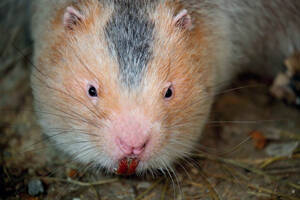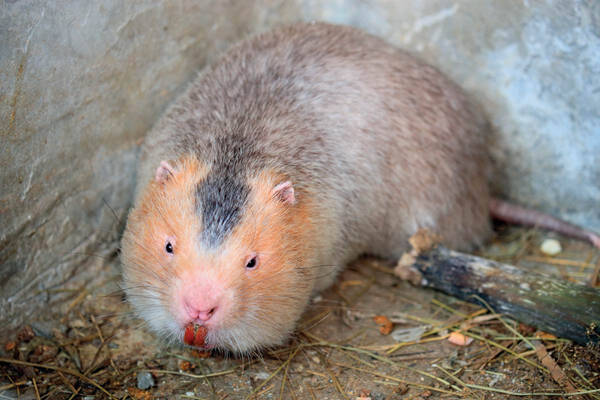Rhizomys sumatrensis
IUCN
LCBasic Information
Scientific classification
- name:Rhizomys sumatrensis
- Scientific Name:Rhizomys sumatrensis,Indomalayan Bamboo Rat,Red-cheeked bamboo rat, Red bamboo rat
- Outline:Rodents
- Family:Rodentia Rhizomysidae Rhizomys
Vital signs
- length:38-48cm
- Weight:2.1-4kg
- lifetime:4-5years
Feature
It is the largest species in the bamboo rat family.
Distribution and Habitat
In China, it is distributed marginally in southern Yunnan. Abroad, it is distributed in Myanmar, Vietnam, Cambodia, Laos, Thailand, Malaysia, and Indonesia.
The giant bamboo rat lives in bamboo forests in mountainous areas. Generally, it lives in secondary forests at an altitude of about 1,000 meters, and often builds caves in gentle hills, dam edges, or the lower part of hillsides.
Appearance
Individuals are large, with an average weight of 3.2kg (2.1-4kg). The body length is 380-480mm. The tail is very long, reaching 150-190mm. The overall fur color on the back of the body is lighter, light brown. The head cheeks to the back of the ears (except for the top of the head) are all pink. There is a diamond-shaped gray-black patch on the top of the head, the rear edge of which is connected to the back hair and gradually fades, and finally merges with the back color. The nose pad is pink, the upper incisors are exposed, and the outer surface is orange. The cheeks below to the chin are white. The abdomen is lighter in color overall, and the hair is sparse. The ears are small, slightly exposed outside the hair, and the ear edges are pink. The tail hair is sparse, and the tip of the tail is pink. The feet are large and have powerful claws.
Details
The bamboo rat belongs to the subfamily Rhizomyinae, and the species is native to Malacca, Malaysia. It was recorded in China very early. The species-level classification status is stable, and there are 6 synonyms. There is some controversy as to whether these synonyms are independent species or subspecies. It lives in low-altitude bamboo forests with soft and fertile soil. It lives underground and sometimes comes out of the cave at night, and even climbs up the bamboo to eat it. It mainly eats bamboo shoots and bamboo, but also other plants, and also eats the roots and fruits of other plants.

The bamboo rat rests during the day and comes out to move at night. It has a strong ability to dig holes. It digs holes under bamboo bushes, and each hole has 2-6 holes. It has the habit of blocking holes. If it is in the hole, it will block the hole with soil to confuse people. There are generally no bamboo rats in the open hole. The cave is quite complicated, up to 9 meters long, and the deepest point is more than 1 meter from the ground. The diameter of the hole is 11-14 cm. There are often large piles of soil thrown outside the hole. They move outside the cave in the morning and evening, and hide in the cave during the day.
Males and females live in the same cave. The breeding season is usually from February to April and from August to October. The gestation period is 22 days, and each litter has 3-5 pups. The eyes of newborn pups are not open, and the body is completely naked and hairless. The eyes open after 24 days, and they can eat hard food after 1 month.

Eat
Bamboo rat meat is sweet, crispy on the outside and tender on the inside, and has no smell of mutton. According to the determination, bamboo rat meat contains 57.78% crude protein, 20.54% crude fat, 17.36% crude ash, 0.84% crude fiber, and is also rich in phosphorus, iron, calcium, vitamin E, amino acids, and steroids. The content of lysine, leucine, and methionine is even higher than that of chicken, duck, goose, pig, cattle, sheep, fish, shrimp, and crab. The protein content of bamboo rat meat is 2.4 times that of chicken, 2.86 times that of beef, and 2.93 times that of rabbit meat. Bamboo rat stew tastes fresher, more fragrant, more delicious, more nutritious, and more mellow than beef soup; fried bamboo rat is more fragrant than chicken and duck, with pure meat and good taste; after braising, the color is bright red, the skin is smooth, the meat is smooth, the taste is delicate, fat but not greasy, and it melts in the mouth. In addition, bamboo rat meat is rich in DHA calcium. DHA calcium can promote the development of adolescent brains and enhance memory, and is known as the "brain protection expert." Teenagers who often eat bamboo rat meat can help strengthen the human body, improve brain function, improve intelligence, and promote retinal development.
Medicinal
Bamboo rat oil
Sourced from the fatty oil of the bamboo rat of the bamboo rat family.
The original morphology of the animal is detailed in the "bamboo rat meat" article.
The taste is light and sweet, and the nature is neutral.
Functions and indications: detoxification and pus discharge, tissue regeneration and pain relief. Treats burns, unexplained swelling and pus, and removes foreign bodies.
Usage and dosage: Apply to the affected area.
Excerpt from "Chinese Medicine Dictionary"








